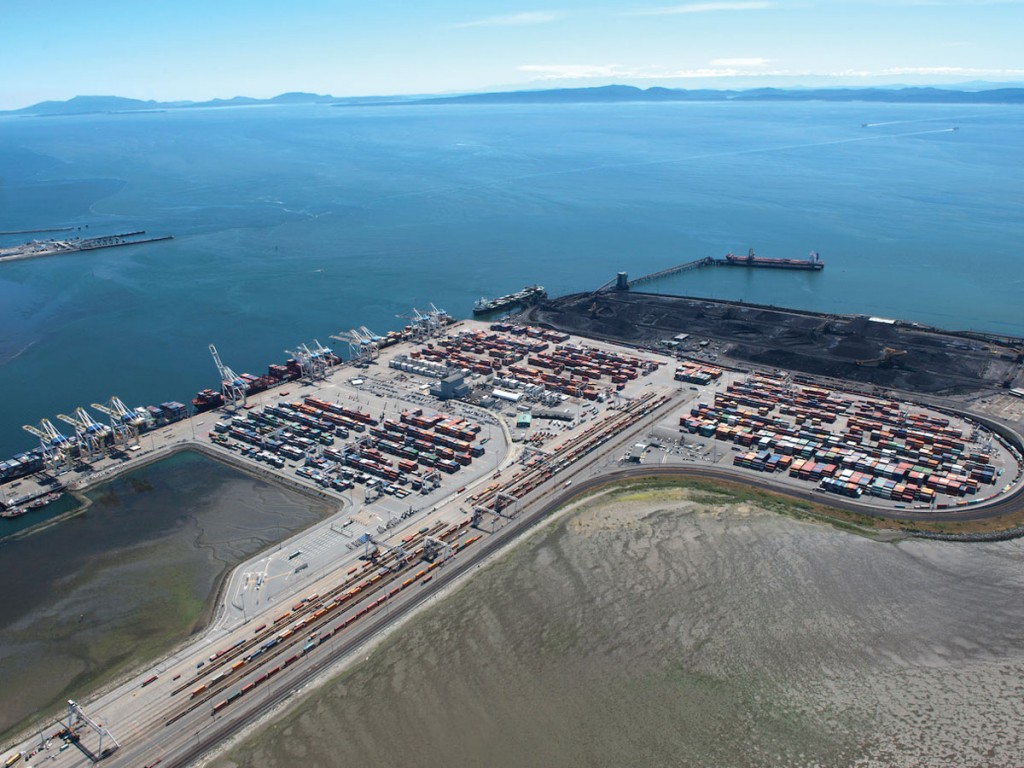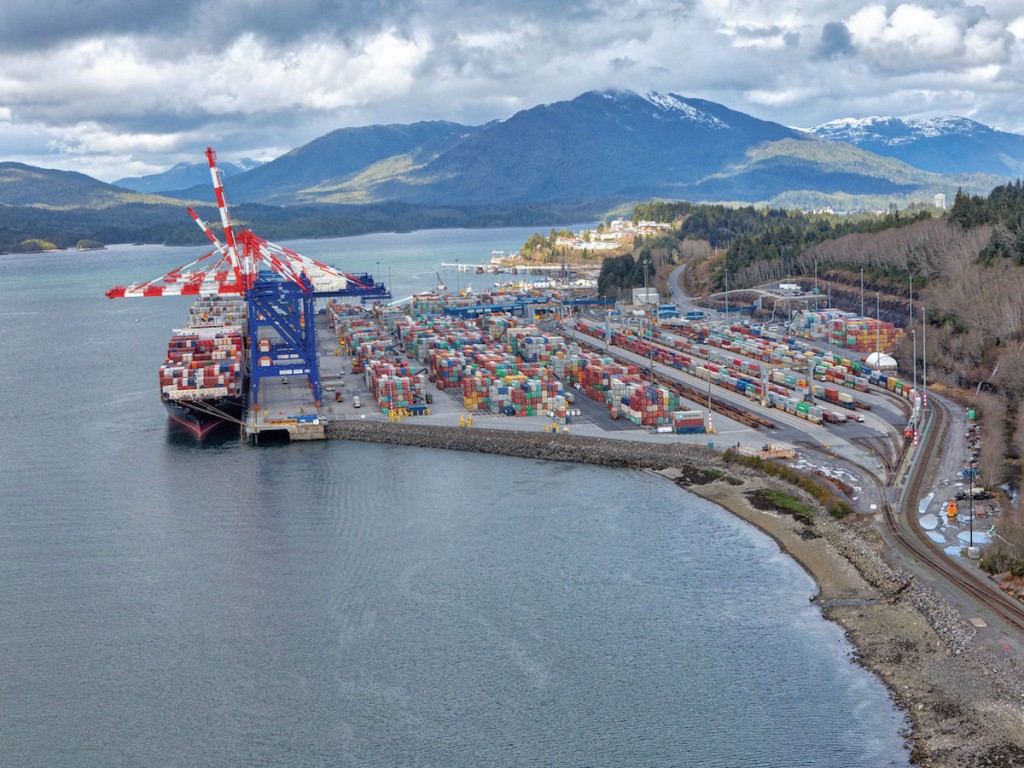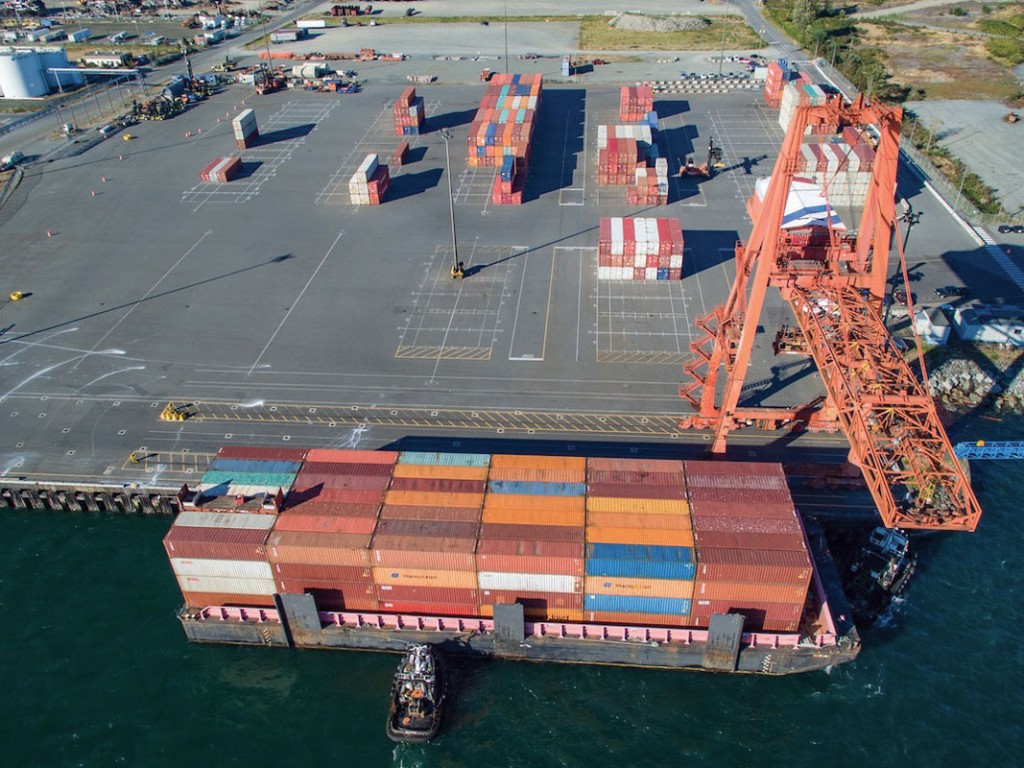Despite the unprecedented global challenges of COVID-19, the leading ports on Canada’s West Coast are still enjoying robust trade with Asia. Vancouver and Prince Rupert even broke cargo records in 2020, with container trends continuing to show strength in 2021. And the Port of Nanaimo, in partnership with DP World, is expanding a major regional, shortsea project with a container-on-barge service.

Port of Vancouver
The Vancouver Fraser Port Authority reports that total cargo volume through Canada’s largest port in 2020 increased by 1% from 144.2 to 145.5 million metric tons over the same period in 2019, with new annual records set for grain, potash, and containers.
China continues to be the port’s largest trading partner, with two-way trade climbing 18% in 2020. China alone accounted for 34.9 million tons of exported and imported cargo. Japan and South Korea rank second and third.
“During what was most definitely a year that will be in the history books amid a myriad of challenges and global economic uncertainty, the value and resiliency of Canada’s largest port has certainly been showcased,” said Robin Silvester, President and CEO of the Vancouver Fraser Port Authority.
For the fifth year in a row, global demand for Canadian grain resulted in a new annual record of 35.1 million tons of grain shipped both in bulk ships and containers, an increase of fully 24% compared to the previous year. Increases in wheat, up 25%, canola, up 45%, and specialty crops, up 12%, contributed to the record.
Container traffic attained a record 3.5 million TEUs, an increase of 2% compared to the previous year.
The port authority recently updated its container forecasts, and indeed the year-to-date figures to end-February appeared to justify the optimism, with the two-month total at 604,863 TEUS – up an impressive 21%.
In response to rising international trade demand, the port authority is continuing to advance the critical infrastructure required to accommodate this growth. Working with industry and government partners across the Lower Mainland, the port authority is leading the development of more than $1 billion worth of infrastructure projects, including two container terminal projects and a number of road and rail infrastructure projects.
However, construction of the port’s proposed multi-billion Terminal 2 container terminal project on Robert’s Bank has run into delays in face of mounting opposition from environmental groups and the City of Delta as well as opposition from Global Container Terminals (GCT). The latter’s Deltaport operation would simply be enlarged whereas the RBT2 project would require the conversion of some 400 acres of intertidal and subtidal habitat to build a new three-berth terminal, expand an existing causeway and a tug basin.
Significantly enough, the Port of Vancouver is currently working on a response slated for this summer to a federal environmental review panel report that concluded the project “would result in numerous adverse residual and cumulative effects” on Dungeness crab, Chinook salmon and migratory birds.
Assuming eventual federal government approval, observers consider actual operation of RBT2 could not occur before 2030.

Prince Rupert Port Authority
For its part, the Prince Rupert Port Authority (PRPA) set another record for annual cargo volumes in 2020, with 32.4 million tons of cargo handled – 9% more than in 2019.
Touting itself as the deepest natural harbour in North America, the Port of Prince Rupert is also 500 nautical miles closer to Asia than any other port in the Pacific Northwest.
“In a year marred by uncertainty, the Port of Prince Rupert has facilitated increased trade in support of Canada’s economic health through the pandemic, enabling over $50 billion in international trade,” commented. Shaun Stevenson, President and CEO, Prince Rupert Port Authority
The Port’s highest total volume to date was led by a rise in exports of coal, propane, and wood pellets. Ridley Terminal saw a year-over-year increase of 26 percent, driven by demand for thermal coal. AltaGas’ Ridley Island Propane Export Terminal marked its first full year of operation in May 2020 and ended the year with 1,159,207 tons loaded onto 27 vessels bound for Asia. Pinnacle Renewable Energy’s Westview Terminal had a record year, exporting 1,474,301 tons of wood pellets, an increase of 33% over 2019.
Factory shutdowns in Asia and locked down economies in North America caused a 19% drop in container traffic in Q2 2020. However, volumes rebounded and DP World’s Fairview Container Terminal finished a mere six percent down with 1,141,390 TEUs moving through the Port for the year, attributed mostly to a decline in the volume of empty containers being shipped through Prince Rupert back to Asia.
In the first two months of 2021, whereas total traffic was trending upwards by 2%, the container outlook was mixed – with export TEUs progressing by 11% and import TEUs down by 16% to show an overall container decline of 5%.
Among recent key developments, DP World has gained regulatory approval for the southern expansion of Fairview Container Terminal that will support a future capacity of 1.8 million TEUs; the British Columbia government is investing C$25 million in a Ridley Island Exports Logistics platform to transload western Canadian resource products for containerized export by sea to international markets.

Port of Nanaimo
Meanwhile, worth watching is the Port of Nanaimo, a key economic driver for the Vancouver Island region. It has big ambitions to develop shortsea shipping on Canada’s West Coast and in this connection signed a 50-year lease agreement in February with DP World.
The Duke Point terminal agreement is conceived as a long-term port-to-port solution for a container-and-barge service between Nanaimo and Vancouver, a distance of 50 miles by road. It will also expand access from Nanaimo to global import/export markets via direct calls to Asia.
Putting things into perspective, Maksim Mihic, CEO and General Manager, DP World (Canada) says: “The introduction of the Duke Point LO/LO (lift-off/lift-on) operation represents a significant milestone in shifting the BC transportation industry from a truck-based, single modal connection to a multimodal transportation industry where truck transport in part will be replaced with shortsea shipping, resulting in significant GHG reductions.”
The signed agreement is an important first step in the planned terminal expansion, currently estimated at costing C$105 million, with a mix of government and private funding.
The project includes nearly doubling the existing berth to 1060 feet and the construction of a new truck gate, warehouse and administration and maintenance building. The existing diesel quay crane will be replaced with two 16 container-wide electric quay cranes. The terminal’s container yard storage area will be increased, creating an overall terminal operational capacity of 280,000 TEUs.




